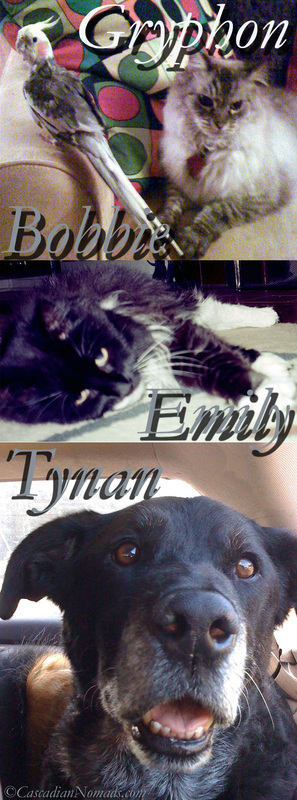
My road to learning about keeping dogs warm has been an interesting adventure in itself. Dog warmth wasn't something my family ever worried about since we only ever had Siberian huskies. We were always careful of the huskies physical condition in hot weather or when backpacking. My dad taught me about caring for the dogs feet in cold weather but that was all I had ever needed to know about dogs in harsh environments. My first dog as an adult, Tynan, was obviously not a husky but his fur was rugged enough to keep him safe in any weather we encountered at home or in travels through Cascadia. Then Tynan's cancer treatment made his previously luxurious, water repellent fur dry and thin. So I got him a coat and boots. Tynan loved his coat and boots. Unfortunately, among all of the wonderful things Tynan taught Wilhelm, loving to wear warm clothes was not one of them. Wilhelm hates wearing anything. However Wilhelm's fur has never been warm or water repellent. In fact it is the opposite. Yet Wilhelm has been snowshoeing and camping with me since he was a puppy. I have learned a lot about keeping my little dog warm throughout our adventures together and I have put together some adventure dog tips for staying safely warm.
Hating coats seems to be an instinct Wilhelm was born with but he was also born with a natural desire to burrow. So I never go anywhere without at least one medium sized fleece blanket to keep him warm. I wrap him in it when we settle into our tent for the night or when we return from a cold outdoor outing. A blanket is often the outer layer of other coats and sweatshirts. It depends on the weather and our outdoor activity but Wilhelm has a base layer, a windproof layer and a water resistant layer with varying leg coverage. Layering is always a great warmth system for humans or dogs because it can change as the weather or activities do. Wilhelm can choose to remove the blanket or I can take any unnecessary layers off. I don't believe I could ever travel with too many dog coats or blankets.
No matter what adventure my dogs and I are on, I am constantly checking in on their health, especially when it is cold. I remove my gloves to feel the dogs ears and feet, making sure their blood is pumping enough to keep their extremities warm. If we are camping, I wake up several times in the night to do this same check. If necessary, I recover the dogs with blankets or add extra blankets. We never camp in temperatures extreme enough for hypothermia to occur but I know the signs and I take extreme care when we are snowshoeing. At the first sign of a shiver, we get back to shelter as quickly as possible. Wilhelm is the dog most likely to shiver and he can be carried back to warmth inside of my coat. I also carry instant heat packets in my first aid kit if I need help keeping myself or a dog warm on the way to safety.
| Too Wet Often Means Too Cold Wilhelm's fur is a sponge. So for many of the outdoor activities we do, keeping him warm also means keeping him dry. Keeping water absorbing dachshund fur dry is made more difficult by the fact that his fur also collects moist debris and snowballs. Being low to the ground has it's adorable advantages and it's wet, dirty and cold disadvantages. Dryness for Wilhelm involves a combination of the right coats and checking him for moisture. Even one layer of dog clothing getting too wet can mean the dog will quickly get too cold. Jason and I have invested in several good snowsuits for Wilhelm. These full coverage dog coats expose as little fur as possible to moisture. Wilhelm's clothing also continues to act as an insulator even when wet. However, we don't have any water proof clothing for our dogs, so we still check constantly to make sure Wilhelm's layers are staying continuing to keep him warm. |
There are so many spectacular views to be enjoyed from snowy peaks or chilly locales. Ever since my first snowshoe up the Glade Trail on Mount Hood with Tynan, I have enjoyed packing a picnic lunch. Yet I always remember that it is harder on dogs than humans to stop and just hang out in the snow. Even if the dogs are wearing boots and coats, they don't have as many advanced fabric layers of clothing as I do. When possible, we stop in the sun. If stopping for more than a few minutes, like for a picnic, I always offer the dogs a non-snowy option for rest. This dog rest is usually a blanket but can also be a warm rock or bare ground. Human or canine, as soon as our bodies stop moving and our hearts stop pumping, the cold affects our bodies much more quickly. I continue to check the dogs physical condition and we get moving again as quickly as needed.





 Follow on Instagram
Follow on Instagram
















